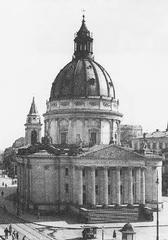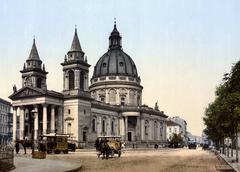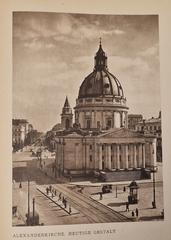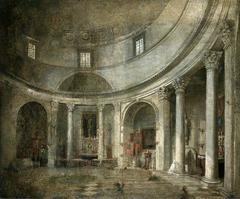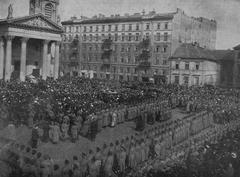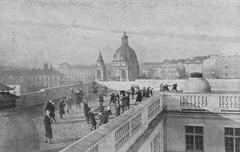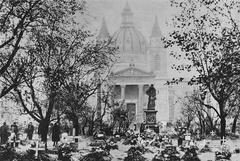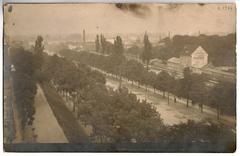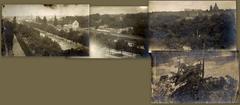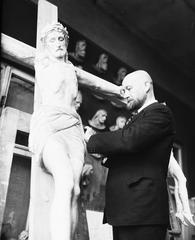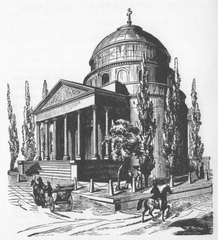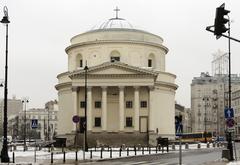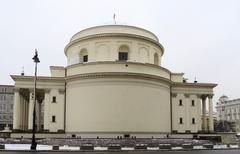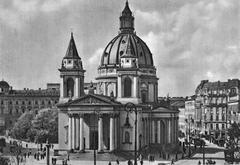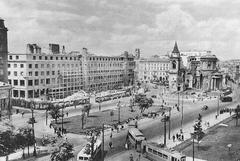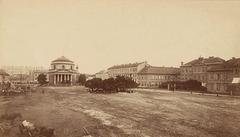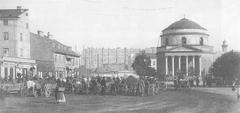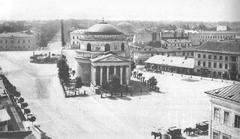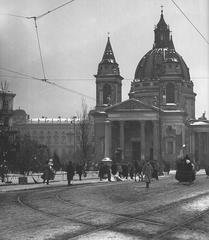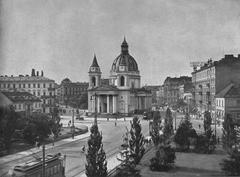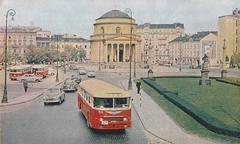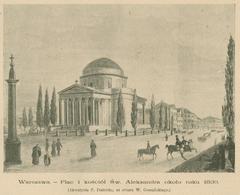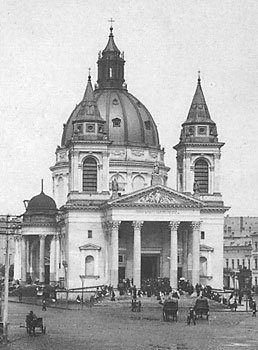
St. Alexander’s Church, Warsaw: Visiting Hours, Tickets, and Historical Guide
Date: 14/06/2025
Introduction
St. Alexander’s Church (Kościół Świętego Aleksandra), prominently located at Three Crosses Square (Plac Trzech Krzyży) in central Warsaw, is a remarkable example of Neoclassical architecture and a testament to Poland’s turbulent yet resilient history. Commissioned in 1818 to honor Tsar Alexander I and Poland’s constitutional hopes, the church has endured architectural transformations, wartime devastation, and meticulous reconstruction—emerging today as both a place of worship and a vital Warsaw landmark. Visitors are welcomed with free access, architectural splendor, and proximity to the Royal Route and other city attractions, making St. Alexander’s Church a must-see destination for history, art, and architecture enthusiasts (Wikipedia; WarsawTour; Sacred Architecture).
Contents
- Introduction
- Historical Overview
- Origins and Founding Context
- Architectural Evolution and Symbolism
- Wartime Destruction and Postwar Reconstruction
- Visiting St. Alexander’s Church: Practical Information
- Visiting Hours and Tickets
- Accessibility
- Guided Tours and Visitor Tips
- Nearby Attractions
- Architectural and Artistic Highlights
- Neoclassical Foundations and Design
- Neo-Renaissance Expansions
- The Dome: Structure and Symbolism
- Interior Features
- Façade and Ornamentation
- Liturgical Art and Furnishings
- Restoration and Preservation
- Visitor Experience and Travel Tips
- Frequently Asked Questions (FAQ)
- Conclusion
- Sources and Further Reading
Historical Overview
Origins and Founding Context
St. Alexander’s Church was commissioned in 1818 by Warsaw’s citizens to commemorate Tsar Alexander I, who granted the constitution to the Congress Kingdom of Poland. The project, led by architect Chrystian Piotr Aigner, was inspired by Rome’s Pantheon, symbolizing Polish aspirations for sovereignty and enlightenment values. The Viceroy of Poland, Prince Józef Zajączek, laid the foundation stone, marking the church as a lasting emblem of civic virtue and national identity (Wikipedia; Academia.edu).
Architectural Evolution and Symbolism
- Neoclassical Era (1818–1825): The original church featured a domed rotunda and a six-columned portico, echoing the Pantheon’s grandeur and classical symmetry. Its circular nave and restrained ornamentation reflected the ideals of order and rationality.
- Neo-Renaissance Transformation (1886–1894): Following changing political circumstances, the church was expanded with side towers and a more elaborate dome, introducing Renaissance elements and increasing its visual prominence during the Russification of Warsaw.
Wartime Destruction and Postwar Reconstruction
In 1944, during the Warsaw Uprising, St. Alexander’s Church was nearly destroyed by German forces. The original dome and much of the structure collapsed. After the war, architect Jan Zachwatowicz led the restoration (1949–1952), returning the church to its Neoclassical roots as a symbol of Warsaw’s resilience and cultural continuity (Trek Zone; WarsawTour).
Visiting St. Alexander’s Church: Practical Information
Visiting Hours and Tickets
- Opening Hours: Daily, generally from 8:00 AM to 8:00 PM. Hours may be reduced during Masses, religious holidays, or special events.
- Tickets: Entry is free for all visitors. Donations are appreciated to support ongoing maintenance and restoration.
Accessibility
- The church is wheelchair accessible, with ramps at the main entrance and accessible restrooms.
- The surrounding square is flat and easy to navigate.
Guided Tours and Visitor Tips
- Guided tours can be arranged through local tour operators and are often included in walks along the Royal Route.
- Tours are available in several languages; group visits should be booked in advance.
- The best visiting times are weekday mornings or late afternoons for a quieter experience.
- Modest dress is advised out of respect for the church’s religious character.
- Photography is permitted without flash, but visitors should be discreet during services.
Nearby Attractions
- Nowy Świat Street: A lively avenue with shops and restaurants.
- Ujazdowski Park: Ideal for a relaxing stroll post-visit.
- Warsaw Old Town: A UNESCO World Heritage site within walking distance.
- The Royal Route: Connects many of Warsaw’s most important cultural sites.
Architectural and Artistic Highlights
Neoclassical Foundations and Design
St. Alexander’s Church is a prime example of Neoclassical ecclesiastical architecture in Poland. The rotunda design, six-columned Corinthian portico, and domed roof reflect the influence of Rome’s Pantheon and the period’s fascination with classical antiquity. The original dome, with a wooden frame clad in copper, soared over 30 meters above the nave (WarsawTour; Culture.pl).
Neo-Renaissance Expansions
In the late 19th century, side towers and an enlarged dome were added, blending Renaissance aesthetics with the original Neoclassical purity. This expansion increased the church’s prominence on the city skyline.
The Dome: Structure and Symbolism
The current dome, rebuilt after World War II in reinforced concrete and copper, rises to about 50 meters. It remains one of Warsaw’s architectural highlights, symbolizing both spiritual ascent and Warsaw’s postwar rebirth (Atlas Obscura).
Interior Features
The interior is characterized by a harmonious rotunda layout with radiating chapels and a luminous nave. Notable artworks include a 17th-century white marble statue of Christ, acquired in Rome, and 20th-century stained glass windows depicting Polish saints and biblical scenes (Poland Travel).
Façade and Ornamentation
The imposing portico features Corinthian columns and a triangular pediment with reliefs depicting scenes from the life of St. Alexander. The sandstone and granite cladding, bronze doors, and refined ornamentation enhance the church’s solemnity.
Liturgical Art and Furnishings
The marble main altar, gilded tabernacle, and sculptures of St. Alexander and St. Stanislaus Kostka are focal points. The oak pulpit with bas-reliefs and a 20th-century organ by Rieger-Kloss contribute to the church’s artistic legacy.
Restoration and Preservation
Ongoing restoration efforts focus on preserving the dome, façade, stained glass, and interior artworks. Modern amenities—such as updated lighting and sound systems—support both religious ceremonies and cultural events. Accessibility improvements ensure the site welcomes all visitors (Warsaw City Hall).
Visitor Experience and Travel Tips
- Peak Times: Weekday mornings and late afternoons are less crowded.
- Cultural Events: The church hosts concerts and lectures—check listings for schedules.
- Dress Code: Modest attire is recommended.
- Nearby Dining: Explore local “milk bars” (bar mleczny) for traditional Polish dishes, such as Prasowy near the church (Jetsetting Fools).
- Public Transport: Multiple tram and bus lines stop at Three Crosses Square, making the church easily accessible.
Frequently Asked Questions (FAQ)
What are the visiting hours?
Generally 8:00 AM – 8:00 PM daily, but hours may be limited during services.
Is there an entrance fee?
No, entrance is free.
Are guided tours available?
Yes, through local operators or as part of Warsaw walking tours.
Is the church wheelchair accessible?
Yes, with ramps at the entrance and accessible restrooms.
Can I take photographs inside the church?
Yes, but avoid flash and be respectful during services.
Can I attend Mass or religious services?
Yes, regular Catholic Masses and religious festivals are held; check the schedule on the official website.
Conclusion
St. Alexander’s Church is a keystone of Warsaw’s cultural, historical, and architectural landscape. Its Neoclassical origins, resilience through war and reconstruction, and role as a spiritual center make it a compelling destination. Free entry, central location, and accessible amenities ensure an inclusive and rewarding experience for all visitors. Plan your visit to enjoy the church’s serene beauty, delve into its layered history, and explore the vibrant neighborhood. For additional resources, download the Audiala app for audio tours, consult official tourism websites, and follow related articles for comprehensive travel guidance.
Visuals and Maps
- Exterior view of St. Alexander’s Church with its Neoclassical dome and portico (alt: “St. Alexander’s Church Warsaw exterior”)
- Interior view showing the marble altar beneath the dome (alt: “St. Alexander’s Church Warsaw interior”)
- Map: Location of St. Alexander’s Church on Warsaw’s Royal Route
For virtual tours and current images, visit the official church website or WarsawTour.
Related Articles
- “Walking the Royal Route: Top Historical Sites in Warsaw”
- “Warsaw’s Postwar Reconstruction: A City Reborn”
- “Guide to Warsaw’s Historical Churches”
Sources and Further Reading
- St. Alexander’s Church, Warsaw - Wikipedia
- Construction and Re-Construction of Saint Alexander’s Church in Warsaw (Academia.edu)
- St. Alexander’s Church Warsaw: Visiting Hours, Tickets, and Architectural Highlights (WarsawTour)
- Continuity in Purpose: Warsaw After World War II (Sacred Architecture)
- Official St. Alexander’s Church website
- Trek Zone: St Alexander’s Church, Warsaw
- 3-Day Warsaw Itinerary (Jetsetting Fools)
- The Church of St Alexander in Warsaw (Blogtravel)

